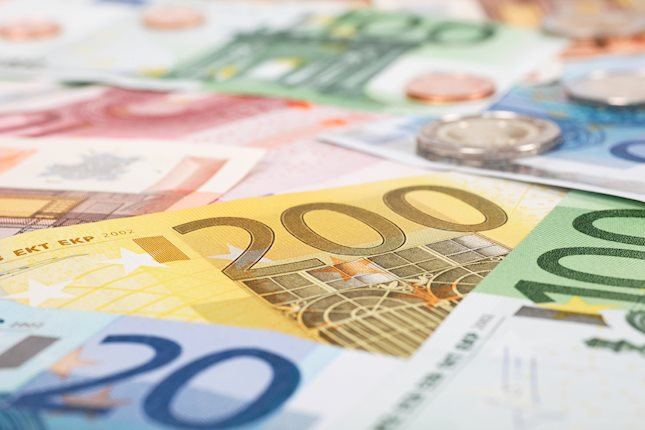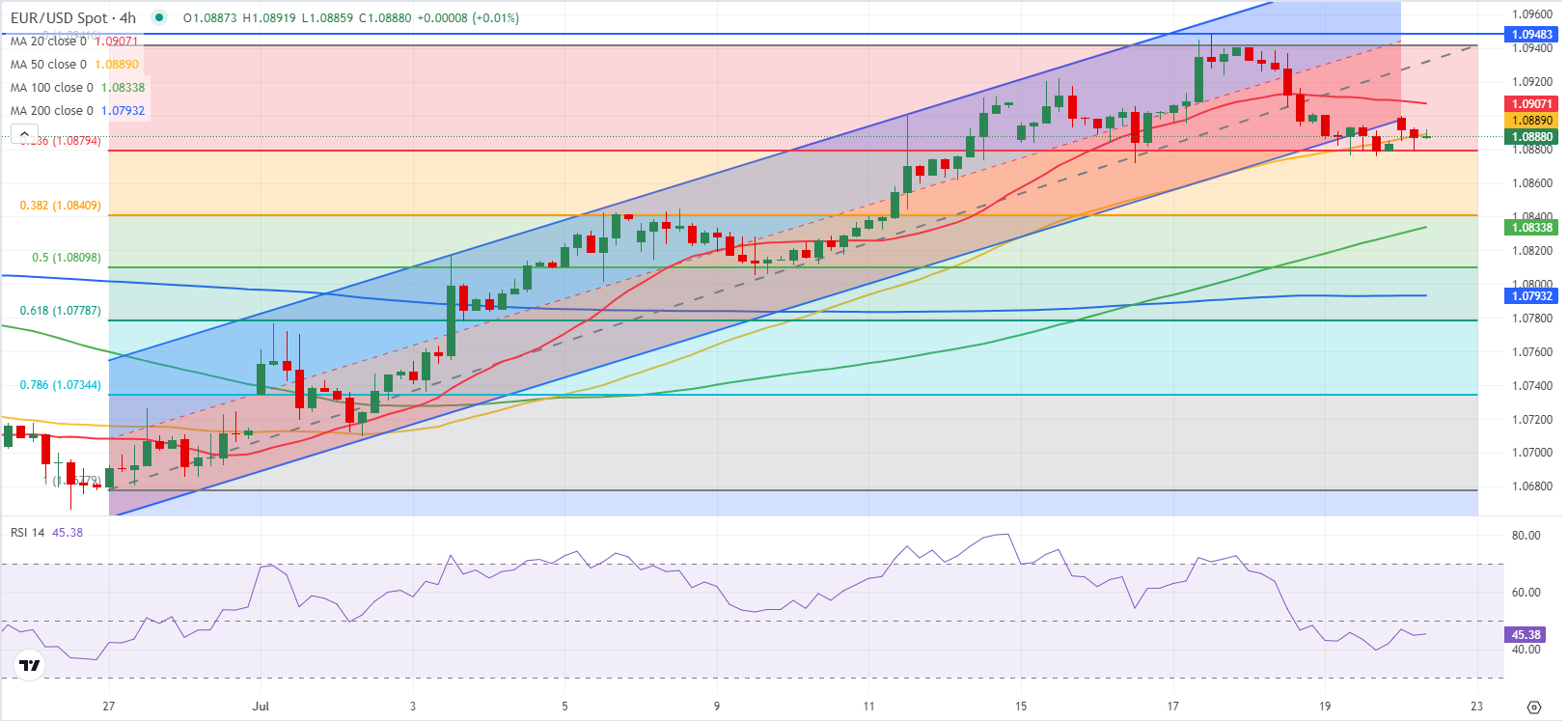- EUR/USD trades in a tight range slightly below 1.0900 early Monday.
- Market reaction to US politics remain subdued at the beginning of the week.
- The pair could stretch lower if 1.0880 support fails.
After closing the last two days of the previous week in negative territory, EUR/USD seems to have entered into a consolidation phase slightly below 1.0900 early Monday. The pair's technical outlook points to a lack of buyer interest in the near term.
Euro PRICE Last 7 days
The table below shows the percentage change of Euro (EUR) against listed major currencies last 7 days. Euro was the strongest against the New Zealand Dollar.
| USD | EUR | GBP | JPY | CAD | AUD | NZD | CHF | |
|---|---|---|---|---|---|---|---|---|
| USD | 0.17% | 0.48% | -0.82% | 0.71% | 1.81% | 1.84% | -0.75% | |
| EUR | -0.17% | 0.34% | -0.80% | 0.72% | 1.68% | 1.85% | -0.73% | |
| GBP | -0.48% | -0.34% | -1.05% | 0.37% | 1.33% | 1.46% | -1.08% | |
| JPY | 0.82% | 0.80% | 1.05% | 1.53% | 2.42% | 2.63% | -0.13% | |
| CAD | -0.71% | -0.72% | -0.37% | -1.53% | 1.03% | 1.13% | -1.46% | |
| AUD | -1.81% | -1.68% | -1.33% | -2.42% | -1.03% | 0.18% | -2.37% | |
| NZD | -1.84% | -1.85% | -1.46% | -2.63% | -1.13% | -0.18% | -2.55% | |
| CHF | 0.75% | 0.73% | 1.08% | 0.13% | 1.46% | 2.37% | 2.55% |
The heat map shows percentage changes of major currencies against each other. The base currency is picked from the left column, while the quote currency is picked from the top row. For example, if you pick the Euro from the left column and move along the horizontal line to the US Dollar, the percentage change displayed in the box will represent EUR (base)/USD (quote).
The US Dollar (USD) benefited from the souring risk mood in the second half of last week and caused EUR/USD to turn south. Additionally, several European Central Bank (ECB) officials hinted at another rate reduction in September on Friday, making it difficult for the Euro to gather strength.
Over the weekend, US President Joe Biden announced that he will no longer run for President at the upcoming election and endorsed Vice President Kamala Harris to be the new nominee. Nevertheless, markets showed little to no reaction to this development.
In the European morning, US stock index futures trade modestly higher on the day. Investors, however, could refrain from taking large positions ahead of Tesla and Google's second-quarter earnings figures, which will be released after the closing bell on Tuesday.
The US economic docket will not feature any high-tier data releases on Monday. Later in the week, S&P Global PMI data from Germany, the Eurozone and the US will be watched closely by market participants. On Thursday, the US Bureau of Economic Analysis will release its first estimate of the second-quarter Gross Domestic Product (GDP) growth ahead of Friday's Personal Consumption Expenditures (PCE) Price Index.
EUR/USD Technical Analysis
EUR/USD failed to return within the ascending regression channel coming from late June after testing the lower limit at the beginning of the week. Additionally, the Relative Strength Index (RSI) indicator on the 4-hour chart stays below 50, reflecting a lack of buyer interest.
On the downside, 1.0880 (Fibonacci 23.6% retracement of the latest uptrend) aligns as immediate support. If EUR/USD falls below that level and starts using it as resistance, 1.0840-1.0835 (Fibonacci 38.2% retracement, 100-period Simple Moving Average) could be seen as next support before 1.0810-1.0800 (Fibonacci 50% retracement, static level).
In case EUR/USD manages to rise above 1.0900-1.0910 (lower limit of the ascending channel, 20-period Simple Moving Average) and stabilize there, technical buyers could take action. In this scenario, 1.0940 (mid-point of the channel, static level) could act as strong resistance before 1.1000 (static level, psychological level) could be set as the next bullish target.
Euro FAQs
The Euro is the currency for the 20 European Union countries that belong to the Eurozone. It is the second most heavily traded currency in the world behind the US Dollar. In 2022, it accounted for 31% of all foreign exchange transactions, with an average daily turnover of over $2.2 trillion a day. EUR/USD is the most heavily traded currency pair in the world, accounting for an estimated 30% off all transactions, followed by EUR/JPY (4%), EUR/GBP (3%) and EUR/AUD (2%).
The European Central Bank (ECB) in Frankfurt, Germany, is the reserve bank for the Eurozone. The ECB sets interest rates and manages monetary policy. The ECB’s primary mandate is to maintain price stability, which means either controlling inflation or stimulating growth. Its primary tool is the raising or lowering of interest rates. Relatively high interest rates – or the expectation of higher rates – will usually benefit the Euro and vice versa. The ECB Governing Council makes monetary policy decisions at meetings held eight times a year. Decisions are made by heads of the Eurozone national banks and six permanent members, including the President of the ECB, Christine Lagarde.
Eurozone inflation data, measured by the Harmonized Index of Consumer Prices (HICP), is an important econometric for the Euro. If inflation rises more than expected, especially if above the ECB’s 2% target, it obliges the ECB to raise interest rates to bring it back under control. Relatively high interest rates compared to its counterparts will usually benefit the Euro, as it makes the region more attractive as a place for global investors to park their money.
Data releases gauge the health of the economy and can impact on the Euro. Indicators such as GDP, Manufacturing and Services PMIs, employment, and consumer sentiment surveys can all influence the direction of the single currency. A strong economy is good for the Euro. Not only does it attract more foreign investment but it may encourage the ECB to put up interest rates, which will directly strengthen the Euro. Otherwise, if economic data is weak, the Euro is likely to fall. Economic data for the four largest economies in the euro area (Germany, France, Italy and Spain) are especially significant, as they account for 75% of the Eurozone’s economy.
Another significant data release for the Euro is the Trade Balance. This indicator measures the difference between what a country earns from its exports and what it spends on imports over a given period. If a country produces highly sought after exports then its currency will gain in value purely from the extra demand created from foreign buyers seeking to purchase these goods. Therefore, a positive net Trade Balance strengthens a currency and vice versa for a negative balance.
Information on these pages contains forward-looking statements that involve risks and uncertainties. Markets and instruments profiled on this page are for informational purposes only and should not in any way come across as a recommendation to buy or sell in these assets. You should do your own thorough research before making any investment decisions. FXStreet does not in any way guarantee that this information is free from mistakes, errors, or material misstatements. It also does not guarantee that this information is of a timely nature. Investing in Open Markets involves a great deal of risk, including the loss of all or a portion of your investment, as well as emotional distress. All risks, losses and costs associated with investing, including total loss of principal, are your responsibility. The views and opinions expressed in this article are those of the authors and do not necessarily reflect the official policy or position of FXStreet nor its advertisers. The author will not be held responsible for information that is found at the end of links posted on this page.
If not otherwise explicitly mentioned in the body of the article, at the time of writing, the author has no position in any stock mentioned in this article and no business relationship with any company mentioned. The author has not received compensation for writing this article, other than from FXStreet.
FXStreet and the author do not provide personalized recommendations. The author makes no representations as to the accuracy, completeness, or suitability of this information. FXStreet and the author will not be liable for any errors, omissions or any losses, injuries or damages arising from this information and its display or use. Errors and omissions excepted.
The author and FXStreet are not registered investment advisors and nothing in this article is intended to be investment advice.
Recommended Content
Editors’ Picks

EUR/USD stabilizes near 1.0550, looks to post weekly gains
EUR/USD continues to fluctuate in a tight channel at around 1.0550 in the American session on Friday as trading action remains subdued with US financial markets heading into the weekend early. The pair looks to end the week in positive territory.

GBP/USD loses traction, retreats below 1.2700
After climbing to its highest level in over two weeks at 1.2750, GBP/USD reverses direction and declines to the 1.2700 area on Friday. In the absence of fundamental drivers, investors refrain from taking large positions. Nevertheless, the pair looks to snap an eight-week losing streak.

Gold pulls away from daily highs, holds near $2,650
Gold retreats from the daily high it set above $2,660 but manages to stay afloat in positive territory at around $2,650, with the benchmark 10-year US Treasury bond yield losing more than 1% on the day. Despite Friday's rebound, XAU/USD is set to register losses for the week.

Bitcoin attempts for the $100K mark
Bitcoin (BTC) price extends its recovery and nears the $100K mark on Friday after facing a healthy correction this week. Ethereum (ETH) and Ripple (XRP) closed above their key resistance levels, indicating a rally in the upcoming days.

Eurozone PMI sounds the alarm about growth once more
The composite PMI dropped from 50 to 48.1, once more stressing growth concerns for the eurozone. Hard data has actually come in better than expected recently – so ahead of the December meeting, the ECB has to figure out whether this is the PMI crying wolf or whether it should take this signal seriously. We think it’s the latter.

Best Forex Brokers with Low Spreads
VERIFIED Low spreads are crucial for reducing trading costs. Explore top Forex brokers offering competitive spreads and high leverage. Compare options for EUR/USD, GBP/USD, USD/JPY, and Gold.
